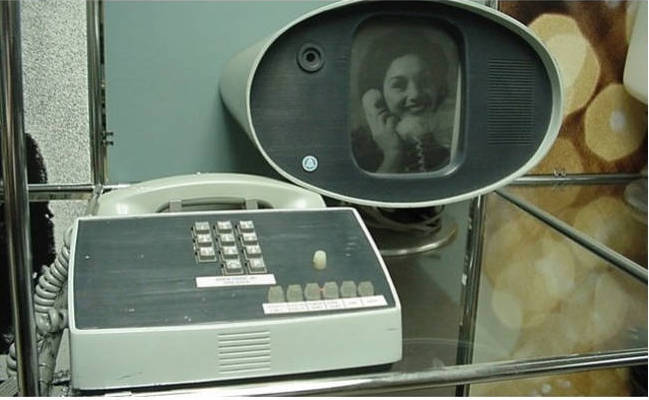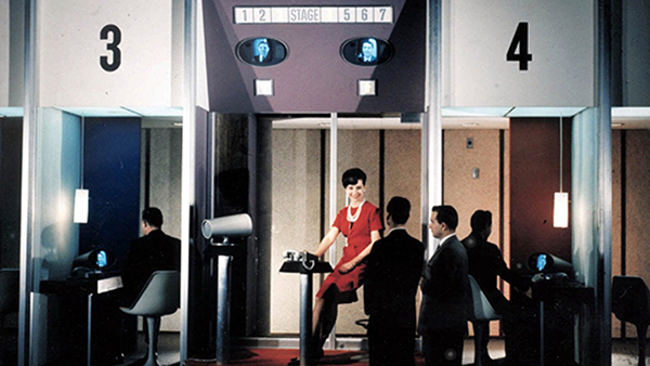April 20, 1964: The first device in history can make video calls
On April 20, 1964 - at the World's Fair event in Flushing Meadow Park, USA, Bell Telephone (belonging to American telecommunications group AT&T) brought an exhibition of a very new device at the time, called Mod 1 Picturephone - precursor to video calling services like Skype or Hangouts today.
History of video call service

Mod 1 Picturephone
To be able to experience the Mod 1 Picturephone , customers will have to enter a small room (the type of call room available at the post offices we see), in front of them will be a machine, including a screen rectangle for video display and a camera. For further clarification, says Jon Gertner, author of The Idea Factory: Bell Labs and the Great Age of American Innovation:
A customer who wants to try the Picturephone will have to go into one of the 7 small rooms and sit in front of the so-called " picture unit" . This device is shaped like a long oval tube, about 30cm wide, 17cm high and 1cm deep. Inside the oval-shaped front is a set of a small camera with a rectangular video screen. The image unit will then be transmitted via a handheld dialer phone (old-fashioned phone) with a row of buttons to control the screen. If you want to make a Picturephone call - or to be more precise, if you want to talk to someone who is also using a Picturephone in another room - just press the "V" button - short for Video. ; You can then talk through a digital phone or via a built-in speaker on the "picture unit".

Above photos are small rooms with devices to help you call video calls
In terms of image quality, users will have to accept viewing black and white images vertically , with a standard of 30 frames per second. A more miserable thing, you must absolutely keep your posture unmoving, because your face will only be displayed in a 16x21-inch frame, so if you want the viewer to be on the side of the wire If you see your face clearly, don't move much. It is known that there is a single button that takes the role of disconnecting the video.
Nearly 13 million VND for 15 minutes of video calling with super low quality (calculated at the exchange rate in 2014)
Although there are limitations like that, the Picturephone still gives people new and exciting experiences. For the first time, people can both call and watch the face of the person they are talking to. However, what is first, something rare is often very expensive. That's right, do you know the price of one call via the Picturephone in 15 minutes? That's $ 80 (ie $ 16 every 3 minutes) - and if you rate it, it will be $ 610 in 2014 for 15 minutes - about $ 13 million for 15 minutes of video calling with super low quality .

First Lady Lady Bird Johnson made a video call through the Picturephone
The Picturephone is a very creative and wonderful idea, so it persuaded AT&T - the big US telecommunications company - to start development and they launched the first commercial product in June 1964. - Picturephone service . The first call was made by First Lady Lady Bird Johnson , who called from the National Capital to another Picturephone booth located at Grand Central Station in New York, USA. Other Picturephone booths were located at the National Geographic headquarters in Washington, the building of Prudential Isurance and the Museum of Science and Industry in Chicago. In order to chat over Picturephone with each other, you will have to book the room first, both must be scheduled in time as well as indicate the location of the two Picturephone chambers to be able to chat with each other. It is known that AT&T's Picturephone service costs significantly more comfortable: $ 1.7 for a minute and a half (based on the exchange rate at the time).
Dream videophone
The pursuit of video calling has actually begun before Bell Telephone introduced the Mod I at World's Fair in the United States. More specifically, almost immediately after Alexander Graham Bell made the first call to Mr. Watson, scientists and many others dreamed about the future of video calls.
A year after Bell applied for a patent on his phone, some people called themselves " Electrician " predicting a combination of fax machines + videophone called " electroscope " in a letter to the editor of the New York Sun site.
A year later, a French science writer, Louis Figuier, remarked that Bell was working on a machine called " telectroscope " - a device that allowed videophone execution.
In December 1878, a French writer and a cartoonist, George du Maurier, predicted that Thomas Edison was working on a videohphone device, called " telephonoscope ".
And in May 6/1880, an inventor named George Carey proposed a system called "seeing by electricity " on the Scientific American page.
However, all that is above is just a theory, a hypothesis and a true " daydream ." It took 30 years for AT&T to turn those dreams into reality. A significant step, US Secretary of Commerce, Herbert Hoover spoke from the videophone chamber in Washington, DC to AT&T Bell Lab in New York.
30 years for AT&T to complete and often commercialize devices that allow videocall implementation, and it will take another 30 years for the US telecommunications group to develop videophone systems to become more feasible and scale. On August 23, 1956, at a meeting of engineers at Radio Academy, AT&T demonstrated the videophone system with the ability to transmit a frame every two seconds. With most of the issues resolved, the company began working on what later became Mod I Picturephone in October 1959.
In order to be motivated to develop a video calling service system, AT&T simply assumed that everyone wanted to chat over video, so the company always wanted to rise forward, rise again, again. and again.
Serial failure failed .
On February 5, 1969, AT&T began selling the Mod II to business customers. Basically, Mod II was able to provide 251 lines, display black and white images with 30fps frames, screens. 5 x 5.5-inch video. However, in mid-1971, AT&T had to stop the service once again due to the indifference from users.
In a report, during the period between 1966 and 1973, AT&T spent half a billion dollars on research and development of Picturephone services, but they did not have anything to publish. Sheldon Hochheiser, who knows the history of AT&T, called the videophone service "the most typical failure in the history of the Bell system ".

Actual image of the Picturephone system
However, absurdly, AT&T decided not to give up and they continued to try again in July 1982, when it launched a very expensive service of Picturephone Meeting Service . It is costly to say that because of a one-hour video call, between two people in New York and Los Angeles, the cost is $ 2,380. Moreover, in order to buy this service, a customer company will have to spend about $ 117,500, and if hired, it costs $ 17,760. After a year since its release, AT&T was shocked to learn that the video calling service was a failure.
It is interesting to know that AT&T is not only interested in video call services. Accordingly, many Japanese companies, including several big names like Mitsubishi and Sony , tried to find opportunities for success in the videophone market, but the outcome they received was similar to that. AT&T.
The long failure of AT&T and Japanese electronics firms in the field of videophone
Then, in January 1992, AT&T once again made it impossible for everyone to believe (because they failed so much earlier), when deciding to return to the videophone market with another device, instead of the Picturephone service that died too many times before. At this time, the American telecom group launched the VideoPhone 2500, which has an integrated LCD screen with color images. VideoPhone 2500 has a starting price of $ 1,500, but then it drops to $ 1,000 and later, AT&T lets customers rent for $ 30 overnight. So after many years, AT&T finally decided to give up the Picturephone and come up with a better device.
The Picturephone is still too big, expensive, uncomfortable to use, and people don't want to see it on the phone . To be successful, AT&T has assumed that it needs to have improved speed. Good, better resolution, smaller, easy to use, affordable and integrated with desktop computers as part of the device.
Conclusion
So you can see the problem of Picturephone - and other later systems like Vialta Beamer, telyHD, C-Phone, 8x8's ViaTV, . are not about whether you can see who is talking to you, It's about having to buy not just one, but two devices: one for you and one for the person you want to video chat.
 Call video today has become popular
Call video today has become popular
However, this problem has been completely solved thanks to the Internet , and more specifically thanks to the explosion of the technology era. Now, built-in webcam devices are everywhere: laptops, smartphones. Because of the device, all we need for video chat is software, which is Skype , introduced in August 2003, then Apple's FaceTime in mid-2010.
Once we have the device and the software, we won't have to buy two different machines or machines just for video calling needs - like the way Picturephone or old services require.
However, despite failures, AT&T scientists, engineers, especially Bell Labs, must be acknowledged by their great efforts to bring video call services to the core. species. They may not succeed, but their studies are premise, the foundation for Skype, Hangouts or FaceTime as far away as now.
- Free international phone calls with VoipBuster
- Global satellite broadband connection in Vietnam
- Will Microsoft 'Origami' make a difference?
- The origin and meaning of April Fool's Day
- April temperature is the highest in over 130 years
- 4 crazy jokes you can make in April Fool's Day
- Skype 2 supports video calling
- Now, you can make free phone calls with Google Home
- Video: Nokia launched a 150-year clip of its development
- 'History' tricks during April Fool's Day
- Video: Japanese history in a fun style
- History and meaning of April 30 and May 1
 Biography of hero Vu A Dinh
Biography of hero Vu A Dinh History of hematology
History of hematology Who is Mr. Tam Da 'Phuc-Loc-Tho' and what does it mean?
Who is Mr. Tam Da 'Phuc-Loc-Tho' and what does it mean? Unbelievable facts about the history of the oil and gas industry: Gasoline used to be cheaper than water, so abundant that it had to be dumped into the river...
Unbelievable facts about the history of the oil and gas industry: Gasoline used to be cheaper than water, so abundant that it had to be dumped into the river...